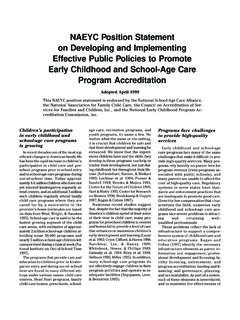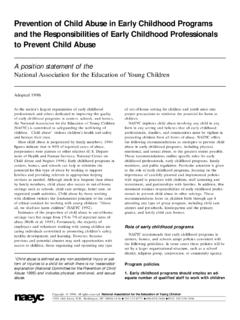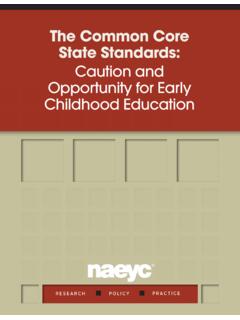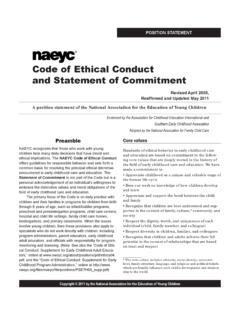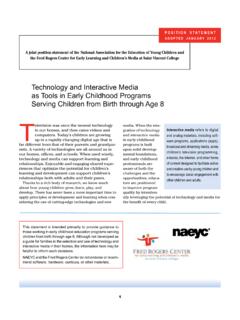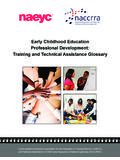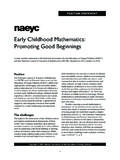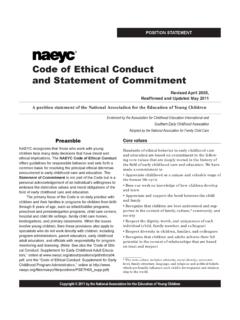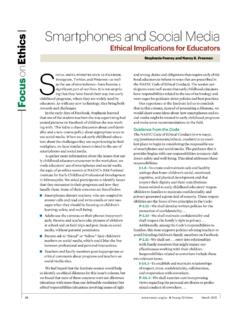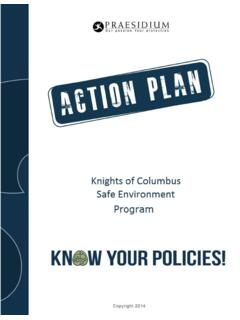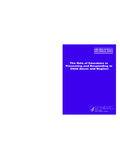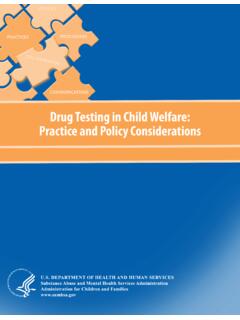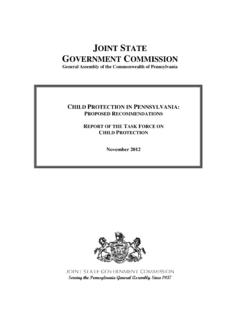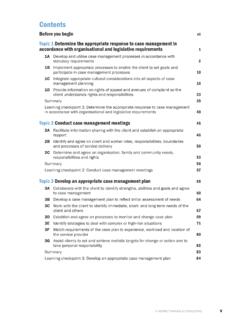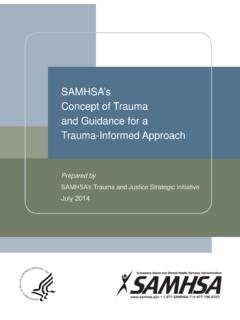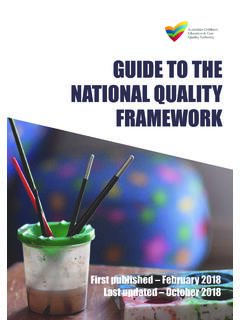Transcription of Ethical Responsibilities - NAEYC
1 3. addressing Ethical Issues In your work, you are very likely to face situations that involve questions of morality and ethics. You may need to weigh competing obligations to children, families, colleagues, and your community and society or make a difficult or unpopular decision. This chapter will help you sort through the following: Determine the nature of a workplace problem: Is it an issue of professional practice or an Ethical issue? Determine the kind of Ethical issue you are facing: Is it a responsibility or a dilemma? Engage in a thorough, systematic decision-making process that leads to an Ethical course of action. The NAEYC Code of Ethical Conduct can help you identify your Responsibilities and guide your decision making when you encounter predicaments that involve ethics: considerations of right and wrong, rights and Responsibilities , conflicting priorities, or human welfare.
2 These Ethical issues are apt to surface as you interact with children, families, coworkers, and community members. They may involve program decisions and might call on you to advocate for children in your community, state, or nation, such as in the Ineffective child Protective Services Agency and Standardized Testing in Kindergarten cases in Chapter 7. This chapter and the four that follow explore some of the Ethical challenges you might encounter and identify how the Code can help answer this important question: What should an Ethical early childhood educator do? . Ethical Responsibilities Ethical Responsibilities are mandates. They describe how you are required to act and what you must or must not do in situations that involve ethics.
3 They are clearly spelled out in the Principles in the NAEYC Code. Following are some examples of these mandates. addressing Ethical Issues 17. Early childhood educators shall not harm children not participate in practices that are emotionally damaging, physically harmful, disrespectful, degrading, dangerous, exploitative, or intimidating to children ( ). use appropriate assessment systems, which include multiple sources of information ( ). not deny family members access to their child 's classroom or program setting ( ). make every effort to communicate effectively with all families in a language that they understand ( ). maintain confidentiality and respect the family's right to privacy ( ).
4 Not participate in practices that discriminate against a coworker because of sex, race, national origin, religious beliefs or other affiliations, age, marital status/family structure, disability, or sexual orientation ( ). be familiar with laws and regulations that serve to protect the children in our programs and be vigilant in ensuring that these laws and regulations are followed ( ). In addition to the Responsibilities outlined in the Code, program administrators'. Responsibilities call on them to ensure that the programs we administer are safe and developmentally appropriate in accordance with standards of the field ( ). develop enrollment policies that clearly describe admission policies and priorities ( ).
5 Work to ensure that ongoing training is available and accessible ( ). manage resources responsibly and accurately account for their use ( ). Accepting the Responsibilities laid out in the Principles may mean that you must take an unpopular position, gather more information, or change practices that you are comfortable with. For example, you may need to challenge a director who has not taken steps to translate program materials for the Hmong families whose children have recently enrolled in her program. When you learn you have a responsibility to use multiple sources of information to appropriately assess children, you may decide to find an assessment that is more comprehensive than the checklist you've been using.
6 If you are a program director, you may find you have an obligation to update your program's outdated staff manual so it accurately describes current policies and standards. Think about how you might respond if, on the third rainy afternoon in a row, the children are restless and the teacher in the next room suggests that you show them a popular animated movie that the children in her group love. The movie offers no educational value. 18 Ethics and the Early Childhood Educator This suggestion is tempting; the movie would occupy the children on an afternoon when they cannot go outside. However, deciding whether or not to let the children watch it is not an Ethical dilemma. Showing the movie would be a violation of your Ethical Responsibilities to be familiar with the knowledge base of early childhood education and to provide worthwhile experiences for children.
7 An Ethical early childhood educator would instead get out tumbling mats or finger paints rather than show the movie. Doing the right thing by honoring the Responsibilities spelled out in the Code and supplements may not always be easy or popular. But to conscientiously embrace your profession's core values and Ethical principles, your actions must demonstrate that you accept these Responsibilities . One of the most important aspects of the Code is its affirmation of what is right it defines the high road of Ethical behavior. Consider a workplace situation in which you were tempted to do what was easy or what others thought was acceptable rather than what you believed was right. What did you do?
8 Were you able to keep sight of your Responsibilities to all involved? How would you describe your thinking about it to someone new to the field? Ethical Dilemmas While some Ethical issues are Responsibilities for which the Code provides The term resolution just one clear-cut course of action, others are Ethical dilemmas describes the course of moral conflicts that involve determining how to act when an individual action decided on through faces conflicting professional values and Responsibilities . A dilemma is the systematic analysis a situation for which there is more than one possible resolution, each of an Ethical dilemma. of which can be justified in moral terms. A dilemma can be viewed as a It suggests that there is situation that deals with two rights or sometimes two wrongs.
9 More than one morally acceptable response; if the Ethical dilemmas are different from other workplace problems in first strategy you try does several ways: not resolve the dilemma, First, in an Ethical dilemma, the legitimate needs and interests of the next one you try might. one individual or group must give way to those of another individual We do not use the term or group. You must do something, and you must choose between two solution when discussing or more actions, each of which has both benefits and costs. This is appropriate responses why you sometimes hear the expression on the horns of a dilemma, to dilemmas because it which refers to the two-pronged nature of these situations. suggests that there is only one correct way to handle a Second, a dilemma may involve a conflict between two or more of the situation.
10 Core Values described in the Code. For example, when a 3-year-old's parents ask the director to move him to a class for 4-year-olds and his teachers feel that he is not ready, the director faces an Ethical addressing Ethical Issues 19. dilemma. The Ideal of maintaining a healthy setting that fosters children's development and the Principle that calls for early childhood educators not to do anything that might harm a child conflict with the Ideals of respecting his family's preferences and the importance of creating a partnership with them. Third, dilemmas rarely have simple answers. An Ethical dilemma cannot be resolved by simply following the rules. In fact, you won't find easy resolutions to dilemmas in this or any other book.
